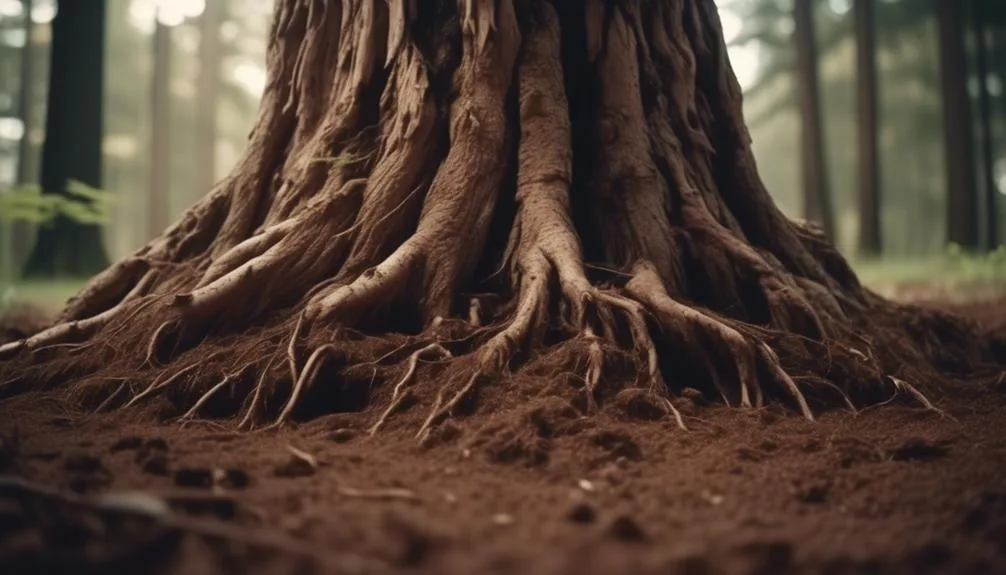Are you seeing roots from your cedar tree popping up around its base? Wondering why this is happening and what can be done about it?
Understanding the reasons behind this issue is key to keeping your tree healthy. Let's explore the causes of cedar tree root exposure and practical solutions to maintain the well-being of your tree.
Understanding Cedar Tree Root Systems
To understand cedar tree root systems, it's essential to grasp the depth and spread of their roots and how they interact with the surrounding environment. Cedar tree roots usually spread widely, sometimes extending beyond the canopy's width. They can also grow to a depth of around 3-7 feet, depending on the soil and environmental conditions.
Understanding root growth is crucial for maintaining healthy cedar trees. Regular inspections of the root systems can help identify any potential issues and ensure proper maintenance. It's important to be mindful of the root spread when planting new trees or planning construction projects near existing cedars.
Common Causes of Cedar Tree Root Exposure
Cedar tree root exposure commonly occurs due to factors such as erosion, compacted soil, construction activities, and soil composition. Understanding the reasons behind this issue can help you address it effectively. Here are some common causes of cedar tree root exposure:
- Erosion: Excessive water flow or wind can erode the soil around the tree, leading to root exposure.
- Compacted Soil: Soil compaction from heavy foot traffic or machinery can restrict root growth, causing roots to surface in search of oxygen.
- Construction Activities: Digging and soil disturbance during construction projects can damage the tree's root system, leading to exposure.
- Soil Composition: Poor soil composition, such as clayey or sandy soil, can lead to inadequate root anchorage and subsequently root exposure.
Understanding these factors can help you take proactive steps to maintain the health of your cedar tree and prevent root exposure issues.
Impact of Surface Roots on Cedar Trees
Excessive exposure of cedar tree roots can have a significant impact on the overall health and stability of the tree. When roots are exposed, the stability of the tree is compromised, increasing the risk of it toppling over during strong winds or storms.
Additionally, exposed roots are more prone to damage from foot traffic, lawnmowers, and other activities, which can further weaken the tree's stability.
Moreover, when roots are visible on the surface, it often indicates soil erosion, which can lead to nutrient deficiencies and water stress for the cedar tree. Soil erosion also exposes the roots to potentially harmful elements and disrupts their ability to anchor the tree securely.
Taking steps to address root exposure is crucial in maintaining the stability and overall health of your cedar tree.
Practical Solutions for Managing Exposed Roots
When managing exposed roots of cedar trees, consider implementing practical solutions to preserve the tree's stability and overall health. Here are some effective strategies to manage the issue:
- Root barriers: Install root barriers to guide the roots away from sensitive areas, such as pavements or structures. These barriers can help redirect the growth of the roots and prevent them from surfacing.
- Soil amendments: Improve the soil quality around the tree by adding organic matter or compost. This can help create a healthier environment for the roots and encourage them to grow deeper into the ground.
- Mulching: Apply a layer of mulch around the base of the tree to regulate soil temperature and moisture, which can reduce surface root growth.
- Proper watering practices: Ensure the tree receives deep, infrequent watering to encourage deep root growth and discourage surface roots.
Long-term Care and Maintenance for Cedar Trees
To ensure the long-term health and vitality of your cedar trees, it's essential to establish a consistent care and maintenance routine that addresses their specific needs and promotes robust growth. Proper pruning techniques and maintaining soil health are crucial aspects of caring for cedar trees. Here are some key long-term care tips to keep your cedar trees thriving:
| Pruning Techniques | Soil Health | Additional Tips |
|---|---|---|
| Prune dead or diseased branches to promote new growth. | Ensure well-draining soil to prevent waterlogging. | Regularly monitor for pest infestations. |
| Use sterilized pruning tools to prevent the spread of diseases. | Mulch around the base of the tree to retain moisture. | Avoid excessive application of fertilizers. |
| Promote proper air circulation within the tree's canopy. | Conduct soil tests to monitor nutrient levels. | Monitor for signs of stress, such as discoloration or wilting. |
Conclusion
In nurturing your cedar tree, addressing surfacing roots through mulching, proper watering, and minimizing foot traffic is crucial. By tending to its root system, you safeguard the tree's long-term well-being.
How will your care for the cedar tree reflect on the overall health of your garden?

My interest in trees started when I first saw the giant sequoias in Yosemite.
I was a teenager then, and I remember thinking, “I need to learn more about this.”
That moment stuck with me.
A few years later, I went on to study forestry at Michigan Tech.
Since graduating, I’ve worked in a mix of hands-on tree care and community education.
I’ve spent over ten years helping people understand how to plant, maintain, and protect the trees in their neighborhoods.
I don’t see trees as just part of the landscape.
They are living things that make a real difference in our daily lives.
